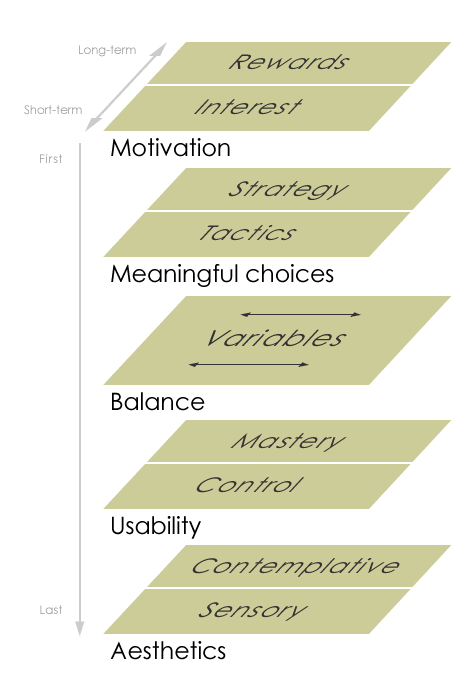Video games are breaking out of the roles they’ve traditionally occupied and are moving into spaces where they collide with UX design. There are games that serve as social glue between old friends, and games that bring strangers together to collaborate on solving problems. There are games that help people meet their life goals, and games that let people reward others for meeting theirs. There are games that facilitate creative self-expression, help people understand the news, train doctors to save lives, and advocate for human rights. As they expand into these realms, the lines separating game design from software UX design are growing fuzzier and less important.
Since both UX and game design are forms of human-computer interaction, they inherently share some common theory, objectives, and practices. In particular, both are centrally concerned with the quality of a person’s experience as enabled by technology. UX practitioners should become accustomed to thinking of video games as just one more medium of design (alongside websites, multimedia, modeling applications, animated illustrations, and so on), although the form of the human experience is fundamentally different in games.
A Playful Model
One of the most familiar and useful frameworks in UX design is Jesse James Garrett’s The Elements of User Experience, but that model is specific to the Web. We need a different model to understand and design for games. Below I propose a similar framework for player experiences that’s intended to help UX designers build games that will be more successful, engaging, and enjoyable. The model is divided into five planes, each of which is further divided into short- and long-term effects. Although it’s simplified, it provides a basis for thinking through the broad elements of design that work together to create the effect of a game.
The model also serves as a process map. The planes are arranged in the sequence in which they would ideally be tackled, starting from the reasons for playing, progressing through the core mechanics of the game, and finishing with the surface level experience. There’s little point in designing for the next plane until the prior one has at least been adequately thought through (although work on the later planes will almost always lead to iterations on the earlier ones). Designers can run into trouble if they skip over planes or start from the wrong end.
1. Motivation
The first thing to think about is who the players are and why they would want to play the game. This plane comprises two main elements. In the short term, there’s the up-front “interestingness” of the experience—the basic spark that grabs people and creates joy in the interaction. In Pac-Man, this is the race to clear the board while being pursued by enemies. In CityVille, it’s the combination of creative control over the city and the challenge of managing its growth. In checkers and chess, it’s the puzzle of figuring out how to attack your opponent while defending your own positions. These are all tied to basic human drives to complete a job, to create, and to feel competent, which are just a handful of the many motivations that make play a fundamental function of living.
The second element of motivation is the system of rewards that sustains interest in the experience over time. Pac-Man has points and leaderboards. CityVille offers access to an expanding set of game items, coupled with a social experience shared among a growing circle of friends. In checkers and chess, it’s the satisfaction of proving that you’re cleverer than your opponent. Rewards become increasingly important the longer a game runs, but they can also grow stale as the player gets used to receiving them. For very long engagements, diversifying and layering rewards can persuade players to stay involved.
2. Meaningful choices
The next plane defines how the game’s structure and rules allow players to exercise choices that influence the outcomes of events. Such meaningful choices are present in all good games, though they can take quite different forms. Chess relies heavily on long-term strategy—the anticipation of what will happen far downstream when you take a move now. Twitchy action games typically involve more short-range tactical decisions, which are completed rapidly and in high volumes at the fine-motor level.
The challenge of consistently making better moves is the fundamental conflict that makes play engaging. Games work best when there’s a partial ambiguity between which actions will result in better or worse outcomes. They can easily lose their appeal when players either have no basis for distinguishing between choices (too much ambiguity), or when there’s clearly only one choice that has any real merit (no ambiguity at all).
3. Balance
This is the extent to which the game’s elements work in combination to create a system that’s appropriately challenging, but which players still perceive as fair and equitable. In an unbalanced role playing game, for example, players might earn gold so easily from battles that they can purchase the most advanced weapons and armor right away for use against the weakest enemies. On the other hand, if they earned too little gold then the game would demand too much work of them and become frustrating.
Video games contain multiple variables for which there is some range of values that need to be set so they’re not too high or too low, but just right. But games are dynamic systems, and the interplay of these variables can be very complex and hard to completely anticipate. Even if a game works really well in a few scenarios, there may be lots of edge cases where it goes completely haywire and the experience becomes unsatisfying. The best way to ensure a balanced game is through iterative prototyping and testing, allowing the problems to emerge from actual play.
4. Usability
While this plane certainly includes all of the interface concerns that we know so well in the UX world, there are also usability considerations that are specific to game experiences. Importantly, the design needs to support a sensible experience, where players understand the things that happen in the game and how their actions affect them.
This means that when players lose they should understand why they lost, and when they win they should understand why they won. When something happens in the game, players should be able to attribute it to a cause that they can perceive and understand. Players should also always be able to understand the actions that are available to them, as well as the objectives they should be working toward (or they should at least have a reasonable opportunity to figure them out). These are the qualities that enable a feeling of control over the experience in the short term, and that allow players to develop mastery of the game over time.
5. Aesthetics
The last plane encompasses the many aspects of the game’s aesthetic design. In the short term there’s the direct sensory experience, which includes images sound as well as the haptics of force feedback and vibrating game controllers. Stylistic choices in writing and art set the game’s tone—whether funny, serious, foreboding, or silly. Many games also contain more contemplative elements that unfold over the long term, such as narratives with evolving story arcs.
A game’s aesthetics can be readily changed without affecting the underlying mechanics governing play. You can swap standard black and white chess pieces out with civil war, ancient Chinese, or Star Trek figures, but you’re still playing chess. So it’s important that the underlying planes of the experience are sound, no matter how glossy the surface is.
Nonetheless, the aesthetic has a profound impact on the player’s experience of the game. You can’t peel the artful qualities of Red Dead Redemption or Plants vs. Zombies away from their game mechanics without completely changing each one’s effect.
What about fun?
You might be wondering how enjoyment and fun factor into this model. Those qualities can’t be designed directly, but rather emerge from the experience when all of the elements work together well. Conversely, fun dies when any of the planes haven’t been adequately addressed.
New Opportunities and New Responsibilities
Video games and UX design are in the process of converging, and each stands to benefit from contact with the other. UX designers have a skill set that lends itself to the design of game experiences, but not without some radical changes in perspective. The first change is to be concerned with the quality of the experience for the sake of the experience. UX designers are accustomed to thinking about experiences that people enjoy because they’re completing some objective that exists outside of the interface, but games must be enjoyed for their gameness. That gives the designer a different kind of responsibility: to design player experiences that are themselves enough reason to play.





